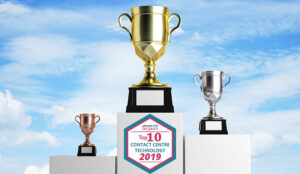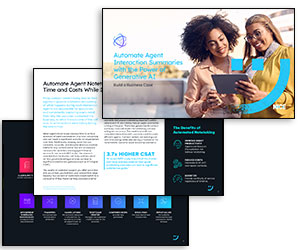Rod Jones shares his step-by-step advice on how to get everyone on board with choosing the right technology for your call centre.
Form a cross-functional team made up of different departments
The starting point of a project to reassess or to plan for new contact centre technologies is to form a cross-functional team made up of relatively senior representatives. These can be drawn from Marketing, Sales, HR, IT, Finance and, if appropriate, Retail, Logistics and other business units.
The team will be required to consider all of the implications of the latest corporate strategies, policies and specific business targets and goals and to interpret these in terms of the contact centre’s real operational requirements.
Determine what will be needed in the short and long term

Defining the actual technical functionalities that will be required by the contact centre presents the next set of challenges.
Functionality must be clearly defined in terms of what will be needed immediately, in the mid-term (12-24 months) and in the longer term – 24+ months. Simultaneously, the team will need to clearly define what will be the non-negotiable “must have” and the “nice-to-have” features and functions.
Your customer service toolkit will include up to twenty-five functions
The contemporary customer contact centre has evolved to become an incredibly complex ecosystem of people, processes, technologies, data and knowledge, largely driven by a number of powerful external influences.
These external drivers range from global and regional economic and financial realities, labour practices and legislative issues, fluctuating social pressures, market demands, the competitive landscape and generational issues and idiosyncrasies.
But fundamentally, when considering new or enhanced or upgraded contact centre solutions, it will boil down to the selection and deployment of a combination of a total of between eighteen and twenty-five different technical functions or applications that will make up the consolidated customer service tool set, the fully integrated contact centre.
The ‘must haves’ will include an ACD that can handle multiple channels
The ‘must haves’ for most contact centres will definitely include a powerful automatic call distributor (ACD) capable of handling multiple channels including voice, email, fax, SMS/MMS, chat and, in the not-too-distant-future, video.
The ability to configure the ACD to route all types of virtual interactions (voice, email, SMS/MMS, fax, and video) to the most appropriately skilled or trained agent is vital. Outbound dialling functionality appropriate to the operation will also be an imperative. Particularly if you are considering outbound telemarketing or telesales or debtor management or debt collection as some of the strategies to increase revenues or manage cash-flow, then more sophisticated dialling technologies such as predictive dialling will be a ‘must have’.
VoIP/SIP architecture, ease of configuration, integration, reporting, scalability, reliability, vendor and support partner credentials are certainty prerequisites when it comes to the selection process for your foundational contact centre platform.
A CRM solution will help provide a good level of customer service
Second in the list of priorities for most contact centres or service-orientated organisations seeking to deploy effective contact centres will be an appropriate CRM (customer relationship management) application or solution that will enable contact centre agents to provide an acceptable level of customer service.
Call and interaction recording is mandatory for any aspiring contact centre to provide the basis for compliance, risk mitigation, quality management and effective coaching and training. The capacity for many contemporary recording solutions to simultaneously record screen and all other contact and customer interaction activity is proving to add significant value to many forms of quality and risk management, and these ‘high-end’ features should be seriously considered.
Be careful to bear in mind that in today’s contact centre environment, it is necessary to ensure that multi-media recording capabilities are procured. (In addition to telephone/voice interactions this will include, for example: screen, webchat, text, social media, video.)
Quality assurance (QA) applications are becoming more important

Increasingly sophisticated quality assurance applications and solutions are becoming more important elements within the contact centre environment.
This is because organisations are starting to grasp the vital importance of truly listening to the voice of the customer and using the insights gleaned in this manner to bolster the depth of information required to provide true business intelligence. QA applications also form a vital aspect of training, coaching and staff incentives and motivation.
A properly configured IVR can create a positive customer experience
Interactive voice response (IVR), whilst considered by many in a negative light, when configured correctly this powerful tool can provide an extremely positive customer experience.
Under certain circumstances IVR can play a significant role in reducing the ‘live’ call load on the contact centre and consequently in reducing the number of agents and the cost associated with staffing.
IVR also plays a major role in the development and deployment of customer self-help and after-hours services. Given the accelerated growth in the level of sophistication and practical applications in natural language speech recognition and voice biometrics, it is also important to consider the ability of your chosen IVR platform to integrate these leading-edge technologies.
The influx of short-shift workers has increased reliance on WFM
Given that between 65% and 75% of the average contact centre’s operational cost will be consumed by manpower, it’s not surprising that operations having upwards of 50 agents are leaning heavily on system-based workforce management (WFM) applications.
The increasing incidence of contract, temporary and short-shift workers is placing increasing reliance on WFM solutions.
CTI will bring vital information and knowledge to the agent desktop
CTI or computer telephony integration, even in its most basic form, will link the operation’s voice and data networks to bring vital information and knowledge to the agent desktop to support all manner of service activities.
The faster and more accurate the information flow to the contact centre agent, the better will be the quality of the customer interaction. First contact resolution (FCR) and fast resolution are key drivers for customer satisfaction and cost reduction through improved efficiencies.
Apps and social media are now an equally important part of any operation

The impact of the social networks on society as a whole is self-evident, just as their impact is being felt in the contact centre and customer service environment.
The tactics, techniques, tools and technologies to manage this massive social and economic phenomenon is certainly a major consideration when planning the development, deployment or enhancement of today’s customer contact centre.
Hand-in-hand with the social network phenomenon is the reality that smartphone and tablet technologies are having an incredible impact on the fundamental relationships between service providers and their customers.
Having an ‘app’ is no longer a nice-to-have but rather a business imperative for any company or organisation intent on maintaining viability and competitive advantage going forward. When designing your new contact centre technologies, the ability to interface with leading-edge mobile technologies will be an imperative.
Process automation can help drive down operational costs
Only a few short years ago, the concept of process automation was fraught with practical, logistical and essentially financial challenges. It used to be an intricate and costly exercise.
However, today’s contact centre platforms provide cost-effective process automation solutions. It is process automation that will play a major role in driving down operational costs whilst driving up efficiencies and customer satisfaction. It is imperative when planning a new contact centre solution set that process automation tools form an integral part of the system.
In tandem with interaction analytics engines, process automation tools can deliver improved customer experiences whilst simultaneously reducing many expensive human interaction elements, the high cost of errors and rework, and lost opportunities.
Identify when technologies will become strategic imperatives
One of the primary tasks of the project team will be to thoroughly investigate all of these options and to make decisions as to their appropriateness and – of equal importance – when in the business lifecycle these technologies will become strategic imperatives.
(For example, in my opinion, integration of all contact centre functionalities into the mobile environment has today become a strategic imperative.)
This done, a great deal of thought and much brainstorming and discussion will be needed to address various options such as ‘build vs buy’, ‘on-premises vs cloud’, ‘integrated single suite vs component-based best-of-breed’.
Other issues such as ‘customise vs configure’, outsource, co-source or hybrid build-operate-transfer models, or strategic sourcing partnerships will need to be considered and evaluated, together with the eternal ‘Opex vs Capex’ debate. To this end, it’s really only a formalised weighted scorecard methodology that will provide value in this early phase of planning.
Get to grips with your operation’s costing model

Rather sooner than later, the project team will be well advised to bring all the financial realities to the fore. Early on in the project, there’s going to be a battle for budget in the boardroom, and in that domain there’s only one phrase that will hold any water: ‘return on investment’.
Before even starting out to plan for the proposed new contact centre technologies, the team is going to have to take a significant back-step – one that’s going to need a great deal of energy and effort.
In today’s harsh world, it’s the economics of business that’s the real driving force. In order to justify any form of investment in new or expanded technologies, the project team should revisit the existing contact centre and really get to grips with the all the factors that currently make up the operation’s costing model.
It is imperative that the team has the ability to present financial models that will give accurate and credible cost-per-minute (or per second) calculations relating to every conceivable aspect of the existing contact centre.
This exercise will have to take into account all manner of customer contact types and channels. As there are well over 400 individually identifiable cost drivers in the average call centre or contact centre, this is no easy task. However, specific call centre costing tools are available.

Rod Jones
Whilst cost-per-contact (by call type and by channel type) is important, cost-per-process is equally vital to the project. The financial realities of ‘errors and rework’, customer churn, staff turnover, cost-of-training (cost to competence) must also be taken into account.
The bottom line is that many of the new-generation technologies can and will provide practical solutions to most of the day-to-day challenges in the operation, but the fact of the matter is that these solutions will come at a cost; quite a significant cost. To be able to justify these costs, the project team will have to rely on their ability to present rational arguments, the majority of which will be based on return on investment (ROI).
With thanks to Rod Jones
Author: Megan Jones
Published On: 17th Feb 2016 - Last modified: 30th Jun 2022
Read more about - Technology, Automatic Call Distributor (ACD), Automation, Customer Relationship Management (CRM), First Contact Resolution (FCR), IVR Solutions, Quality, Social Media, Workforce Management (WFM)







































Great post, very informative, sharing with my team! 🙂 Thank you!